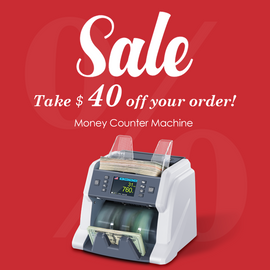Cash handling is an essential yet tedious task for grocery retailers. Counting cash, making deposits, and reconciling transactions can be time-consuming and error-prone. However, with the right practices and technology, retailers can streamline their cash handling process to improve efficiency and security. In this article, we'll discuss the best practices and emerging trends that grocery retailers can adopt to optimize their cash handling operations, and provide real-life examples of businesses that have successfully implemented these practices.
Best Practices for Improving Cash Handling Efficiency and Security
Implement Advanced Cash Handling Technology
Currency counters, smart safes, and point-of-sale systems can automate cash handling processes and reduce errors. For instance, currency counters can count cash accurately and quickly, while smart safes can secure cash and prevent theft.
Example: One business that has successfully implemented cash management technology is a small retail store. Instead of counting cash by hand, they invested in a currency counter that counts cash accurately and quickly, saving them time and reducing errors.
Maximizing Cash Security
Implementing policies for opening and closing registers, using smart safe technology, and training employees on safe cash handling practices can improve security. For instance, using sealed and serialized bags for deposits and armored car services or taking deposits to the bank during daylight hours can minimize cash exposure.
Example: A convenience store implemented smart safe technology to secure their cash and prevent theft. They also trained their employees on safe cash handling practices and implemented policies for opening and closing registers to improve security.
Enhancing Accuracy and Efficiency with Electronic Record-keeping
Keeping a clear trail of the cash handling process through electronic receipts and transaction logs can reduce human errors and quickly identify and correct mistakes.
Example: A small business owner implemented a point-of-sale system that automatically generates electronic receipts and transaction logs. This helped them keep a clear trail of the cash handling process and quickly identify and correct any mistakes.
Improving Cash Handling Competency and Morale through Employee Training
Providing regular training to employees on the cash handling process can ensure minimal errors and eliminate bad cash handling habits. Reinforcing the importance of accuracy and security can also improve employee morale.
Example: A restaurant provides regular training to their employees on cash handling processes and emphasizes the importance of accuracy and security. They also provide re-training sessions to refresh employees' knowledge and improve their skills.
Standardize the Cash Handling Process
Standardizing the cash handling process based on the unique needs of the business can create consistency and reduce errors. This includes determining who handles cash, how much they handle, and when to make deposits based on location.
Example: A popular coffee chain has standardized their cash handling process by designating specific employees to handle cash, setting limits on how much cash they can handle, and requiring daily deposits to be made.
Additional Cash Controls for Minimizing Cash Loss
In addition to the best practices outlined above, grocery retailers should have the following cash controls in place to minimize the risk of cash loss due to theft or errors:
- Limiting access to cash: Retailers should limit access to cash by designating specific employees to handle cash and setting limits on how much cash they can handle. This can help reduce the risk of theft or errors.
- Conducting regular cash audits: Regular cash audits can help deter employee theft and ensure that cash handling procedures are being followed correctly. Audits can also help identify any discrepancies or errors that need to be addressed.
- Implementing cash handling policies: Clear policies for cash handling can reduce the risk of theft by ensuring that all employees are following the same procedures. Policies can include procedures for opening and closing registers, handling cash deposits, and reporting discrepancies.
- Using security cameras: Security cameras can deter theft and provide evidence in the event of any issues. Cameras should be strategically placed to cover areas where cash is handled, such as cash registers, safes, and deposit areas.
Emerging Trends for Grocery Retailers to Watch 2023
Retailers should keep an eye on the following trends to stay competitive and meet the evolving needs of consumers:Expansion of digital shopping and delivery
-
Expansion of digital shopping and delivery: Consumers are increasingly turning to online shopping and home delivery for their grocery needs. Retailers who offer digital shopping and delivery options can provide convenience and flexibility to their customers.
-
Increase in automation in stores: Automation can help retailers streamline their operations and provide a better shopping experience for customers. Self-checkout machines, automated inventory management, and mobile ordering and payment options are just a few examples of how retailers are using automation to improve their stores.
-
Acceleration of premium products: Consumers are willing to pay a premium for high-quality and unique products. Retailers who offer premium products can differentiate themselves from their competitors and attract customers who are willing to pay more for quality.
-
Move to one-stop shopping: Consumers are looking for convenience and value, and retailers who can provide a wide range of products and services under one roof can meet those needs. Retailers who offer groceries, pharmacy, and other services in one location can provide a more convenient shopping experience for their customers.
-
Improvement in consumer data usage: Retailers who can effectively collect and analyze consumer data can gain valuable insights into their customers' needs and preferences. By using this data to personalize promotions, improve product offerings, and enhance the shopping experience, retailers can build stronger relationships with their customers.
Conclusion
By following the best practices outlined above, implementing additional cash controls, and investing in automated cash handling solutions, grocery retailers can improve efficiency, accuracy, and security while minimizing cash loss. Staying agile and adapting to changing consumer preferences and behaviors is key to remaining competitive in a rapidly changing environment.







